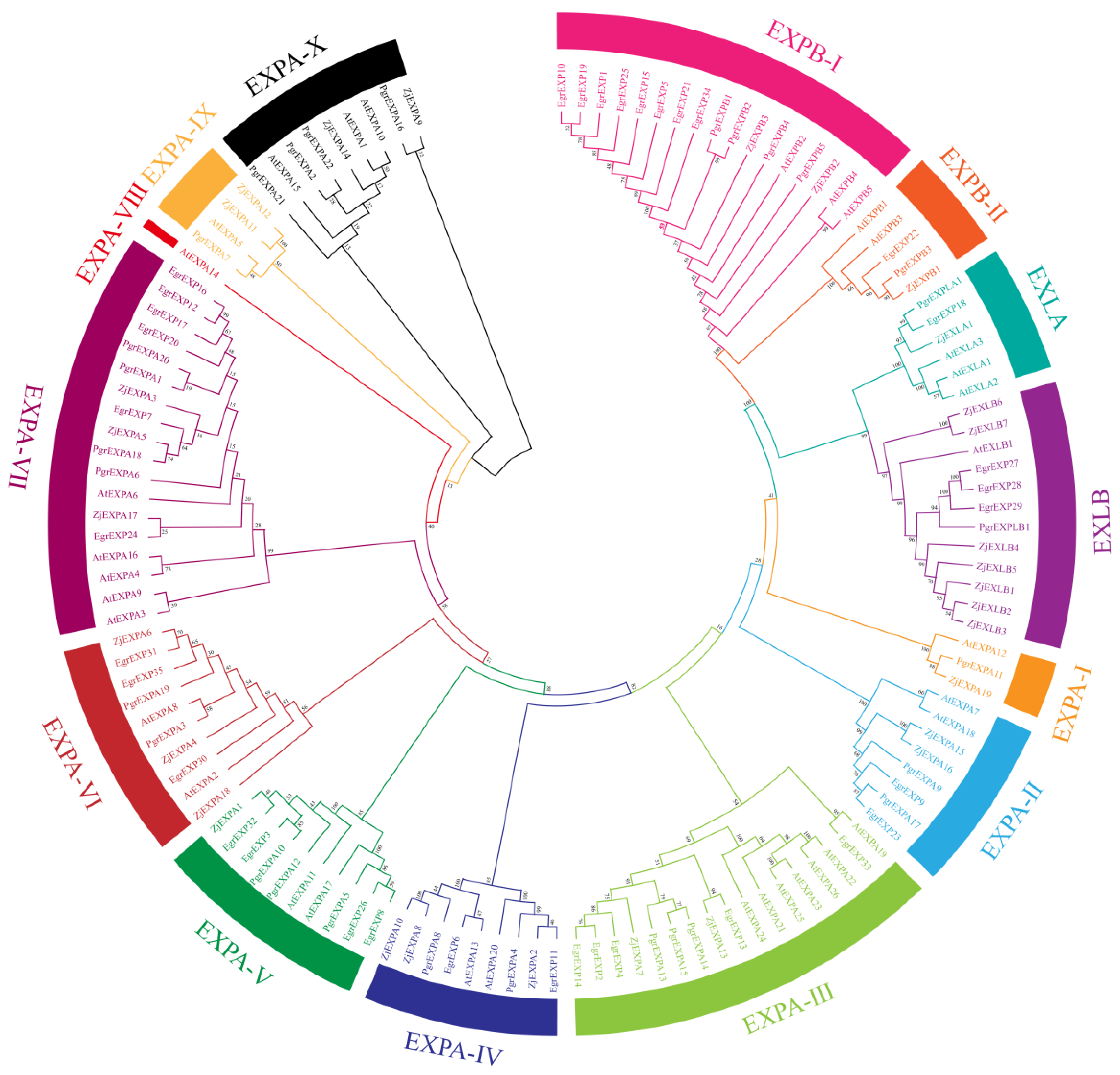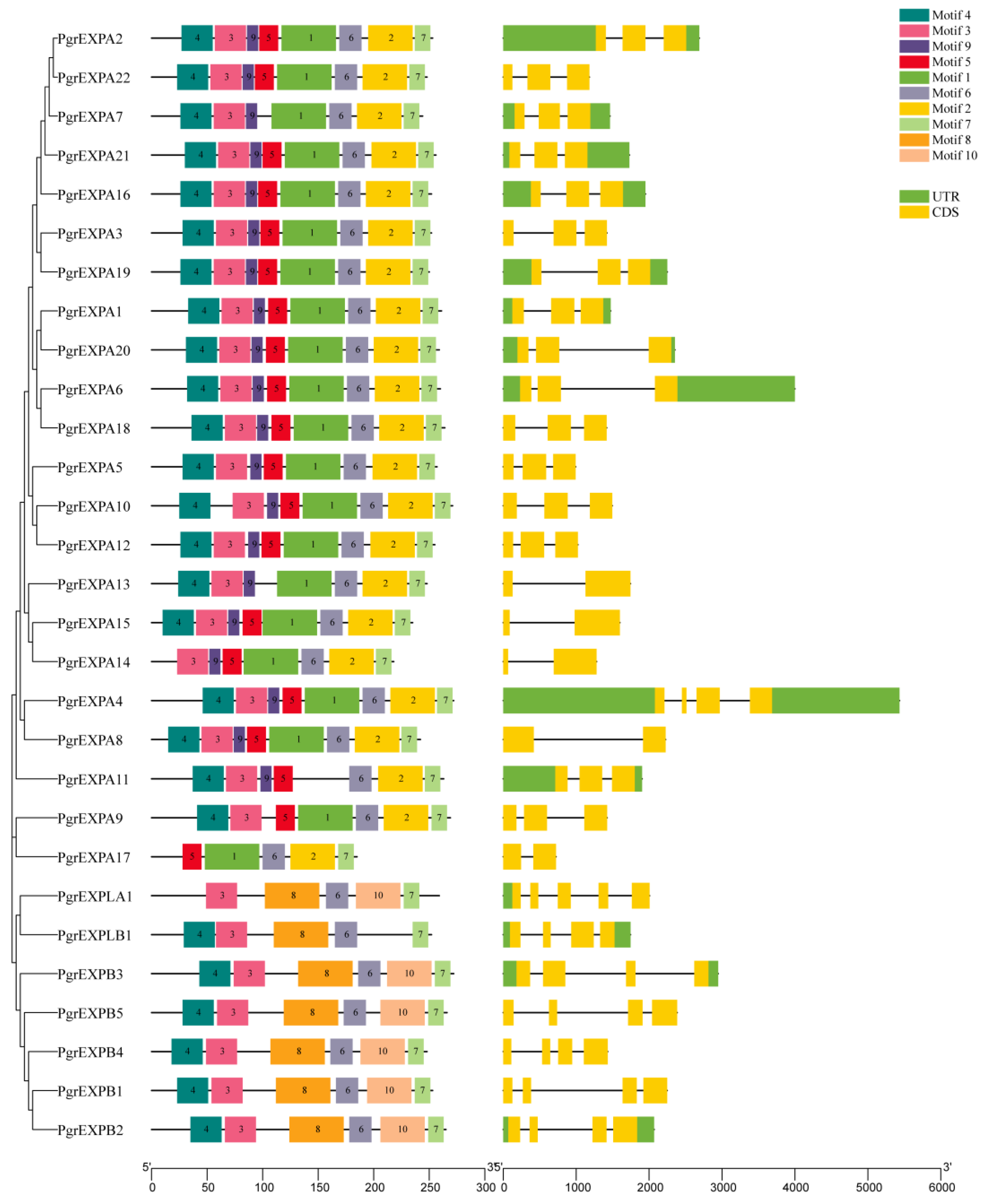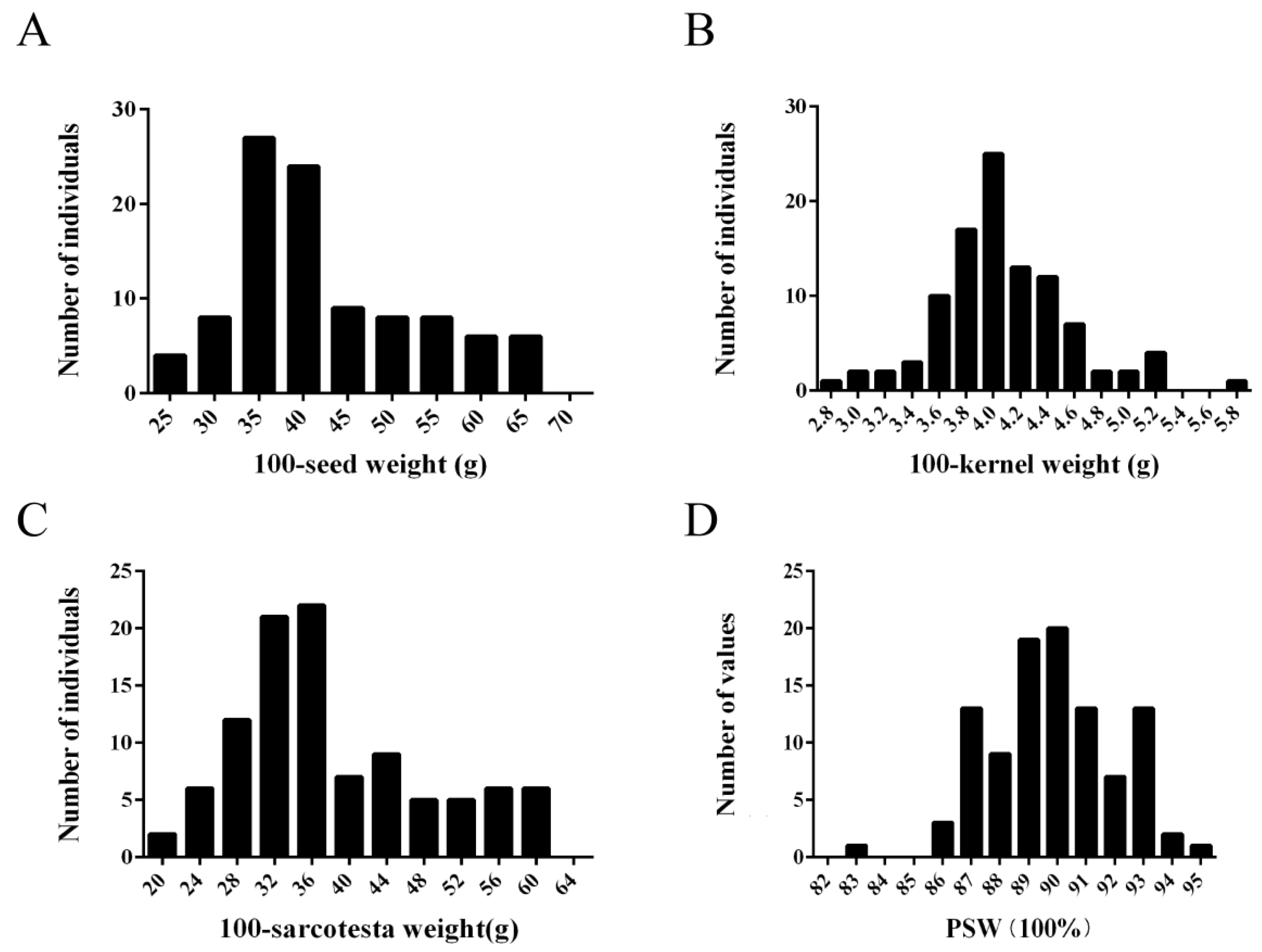Identification of Candidate Expansin Genes Associated with Seed Weight in Pomegranate (Punica granatum L.)
Abstract
:1. Introduction
2. Materials and Methods
2.1. Plant Materials
2.2. Measurements of Seed Weight Traits
2.3. Identification of the PgrEXPs and Phylogenetic Tree Construction
2.4. Protein Properties, Chromosomal Location, and Gene Structure Analysis
2.5. Transcriptome Analysis of the PgrEXP Genes
2.6. DNA Extraction, Primer Design, PCR Sequencing, and Gene-Based Association Analysis
3. Results
3.1. The PgrEXPs in the Pomegranate Genome
3.2. Expression Patterns of PgrEXPs Revealed by Transcriptome Analysis
3.3. Association between PgrEXPs and Seed Weight in Pomegranate
4. Discussion
5. Conclusions
Supplementary Materials
Author Contributions
Funding
Institutional Review Board Statement
Informed Consent Statement
Data Availability Statement
Conflicts of Interest
References
- Holland, D.; Hatib, K.; Bar-Ya’akov, I. Pomegranate: Botany, horticulture, breeding. Hortic. Rev. 2009, 35, 127–191. [Google Scholar] [CrossRef]
- Narzary, D.; Yazdanbakhsh, N.; Rana, T. Taxonomy, botany and physiology. In The Pomegranate: Botany, Production and Uses; CAB International: Wallingford, UK, 2021; pp. 15–58. [Google Scholar]
- Martinez-Nicolas, J.J.; Melgarejo, P.; Legua, P.; Garcia-Sanchez, F.; Hernández, F. Genetic diversity of pomegranate germplasm collection from Spain determined by fruit, seed, leaf and flower characteristics. PeerJ 2016, 4, e2214. [Google Scholar] [CrossRef] [PubMed]
- Prasad, R.; Mali, P. Effect of different levels of nitrogen on quality characters of pomegranate fruit cv. Jalore Seedless. Haryana J. Hortic. Sci. 2000, 29, 186–187. [Google Scholar]
- Karimi, H.R.; Mirdehghan, S.H. Effects of Self, Open, and Supplementary Pollination on Growth Pattern and Characteristics of Pomegranate Fruit. Int. J. Fruit Sci. 2015, 15, 382–391. [Google Scholar] [CrossRef]
- Qin, G.; Liu, C.; Li, J.; Qi, Y.; Gao, Z.; Zhang, X.; Yi, X.; Pan, H.; Ming, R.; Xu, Y. Diversity of metabolite accumulation patterns in inner and outer seed coats of pomegranate: Exploring their relationship with genetic mechanisms of seed coat development. Hortic. Res. 2020, 7, 10. [Google Scholar] [CrossRef] [PubMed]
- Pujari, K.H.; Rane, D.A. Concept of Seed Hardness in Pomegranate—I) Anatomical Studies in Soft and Hard Seeds of ’Muskat’ Pomegranate. In Proceedings of the III International Symposium on Pomegranate and Minor Mediterranean Fruits, Tai’an, China, 20–24 September 2013; pp. 97–104. [Google Scholar] [CrossRef]
- Cosgrove, D.J. Loosening of plant cell walls by expansins. Nature 2000, 407, 321–326. [Google Scholar] [CrossRef] [PubMed]
- Sampedro, J.; Cosgrove, D.J. The expansin superfamily. Genome Biol. 2005, 6, 242. [Google Scholar] [CrossRef] [PubMed]
- ZhiMing, Y.; Bo, K.; XiaoWei, H.; ShaoLei, L.; YouHuang, B.; WoNa, D.; Ming, C.; Hyung-Taeg, C.; Ping, W. Root hair-specific expansins modulate root hair elongation in rice. Plant J. 2011, 66, 725–734. [Google Scholar] [CrossRef]
- Tabuchi, A.; Li, L.; Cosgrove, D.J. Matrix solubilization and cell wall weakening by β-expansin (group-1 allergen) from maize pollen. Plant J. 2011, 68, 546–559. [Google Scholar] [CrossRef]
- Dotto, M.C.; Martínez, G.A.; Civello, P.M. Expression of expansin genes in strawberry varieties with contrasting fruit firmness. Plant Physiol. Biochem. 2006, 44, 301–307. [Google Scholar] [CrossRef]
- Guo, W.; Zhao, J.; Li, X.; Qin, L.; Yan, X.; Liao, H. A soybean β-expansin gene GmEXPB2 intrinsically involved in root system architecture responses to abiotic stresses. Plant J. 2011, 66, 541–552. [Google Scholar] [CrossRef]
- Zhou, S.; Han, Y.-Y.; Chen, Y.; Kong, X.; Wang, W. The involvement of expansins in response to water stress during leaf development in wheat. J. Plant Physiol. 2015, 183, 64–74. [Google Scholar] [CrossRef]
- Calderini, D.F.; Castillo, F.M.; Arenas-M, A.; Molero, G.; Reynolds, M.P.; Craze, M.; Bowden, S.; Milner, M.J.; Wallington, E.J.; Dowle, A.; et al. Overcoming the trade-off between grain weight and number in wheat by the ectopic expression of expansin in developing seeds leads to increased yield potential. New Phytol. 2020, 230, 629–640. [Google Scholar] [CrossRef]
- Bae, J.M.; Kwak, M.S.; Noh, S.A.; Oh, M.-J.; Kim, Y.-S.; Shin, J.S. Overexpression of sweetpotato expansin cDNA (IbEXP1) increases seed yield in Arabidopsis. Transgenic Res. 2014, 23, 657–667. [Google Scholar] [CrossRef]
- Castillo, F.M.; Canales, J.; Claude, A.; Calderini, D.F. Expansin genes expression in growing ovaries and grains of sunflower are tissue-specific and associate with final grain weight. BMC Plant Biol. 2018, 18, 327. [Google Scholar] [CrossRef] [PubMed]
- Qin, G.; Xu, C.; Ming, R.; Tang, H.; Guyot, R.; Kramer, E.M.; Hu, Y.; Yi, X.; Qi, Y.; Xu, X.; et al. The pomegranate (Punica granatum L.) genome and the genomics of punicalagin biosynthesis. Plant J. 2017, 91, 1108–1128. [Google Scholar] [CrossRef] [PubMed]
- Luo, X.; Li, H.; Wu, Z.; Yao, W.; Zhao, P.; Cao, D.; Yu, H.; Li, K.; Poudel, K.; Zhao, D.; et al. The pomegranate (Punica granatum L.) draft genome dissects genetic divergence between soft- and hard-seeded cultivars. Plant Biotechnol. J. 2020, 18, 955–968. [Google Scholar] [CrossRef] [PubMed]
- Yuan, Z.; Fang, Y.; Zhang, T.; Fei, Z.; Han, F.; Liu, C.; Liu, M.; Xiao, W.; Zhang, W.; Wu, S.; et al. The pomegranate (Punica granatum L.) genome provides insights into fruit quality and ovule developmental biology. Plant Biotechnol. J. 2018, 16, 1363–1374. [Google Scholar] [CrossRef] [PubMed]
- Tamura, K.; Stecher, G.; Peterson, D.; Filipski, A.; Kumar, S. MEGA6: Molecular Evolutionary Genetics Analysis Version 6.0. Mol. Biol. Evol. 2013, 30, 2725–2729. [Google Scholar] [CrossRef] [PubMed]
- Krzywinski, M.; Schein, J.; Birol, I.; Connors, J.; Gascoyne, R.; Horsman, D.; Jones, S.J.; Marra, M.A. Circos: An information aesthetic for comparative genomics. Genome Res. 2009, 19, 1639–1645. [Google Scholar] [CrossRef]
- Hu, B.; Jin, J.; Guo, A.-Y.; Zhang, H.; Luo, J.; Gao, G. GSDS 2.0: An upgraded gene feature visualization server. Bioinformatics 2015, 31, 1296–1297. [Google Scholar] [CrossRef]
- Bailey, T.L.; Boden, M.; Buske, F.A.; Frith, M.; Grant, C.E.; Clementi, L.; Ren, J.; Li, W.W.; Noble, W.S. MEME SUITE: Tools for motif discovery and searching. Nucleic Acids Res. 2009, 37, w202–w208. [Google Scholar] [CrossRef]
- Chen, C.J.; Chen, H.; Zhang, Y.; Thomas, H.R.; Frank, M.H.; He, Y.H.; Xia, R. TBtools: An Integrative Toolkit Developed for Interactive Analyses of Big Biological Data. Mol. Plant 2020, 13, 1194–1202. [Google Scholar] [CrossRef] [PubMed]
- Doyle, J. Isolation of DNA from small amounts of plant tissues. Focus 1990, 12, 13. [Google Scholar]
- Kende, H.; Bradford, K.; Brummell, D.; Cho, H.-T.; Cosgrove, D.; Fleming, A.; Gehring, C.; Lee, Y.; Mcqueen-Mason, S.; Rose, J.; et al. Nomenclature for members of the expansin superfamily of genes and proteins. Plant Mol. Biol. 2004, 55, 311–314. [Google Scholar] [CrossRef] [PubMed]
- Hou, L.; Zhang, Z.; Dou, S.; Zhang, Y.; Pang, X.; Li, Y. Genome-wide identification, characterization, and expression analysis of the expansin gene family in Chinese jujube (Ziziphus jujuba Mill.). Planta 2019, 249, 815–829. [Google Scholar] [CrossRef] [PubMed]
- Li, N.; Li, Y. Maternal control of seed size in plants. J. Exp. Bot. 2015, 66, 1087–1097. [Google Scholar] [CrossRef] [PubMed]
- Savadi, S. Molecular regulation of seed development and strategies for engineering seed size in crop plants. Plant Growth Regul. 2018, 84, 401–422. [Google Scholar] [CrossRef]
- Xu, X.; Wang, Y.; Zhao, X.; Yuan, Z. Uncovering the Expansin Gene Family in Pomegranate (Punica granatum L.): Genomic Identification and Expression Analysis. Horticulturae 2023, 9, 539. [Google Scholar] [CrossRef]
- Zhang, X.; Wang, S.; Ren, Y.; Gan, C.; Li, B.; Fan, Y.; Zhao, X.; Yuan, Z. Identification, Analysis and Gene Cloning of the SWEET Gene Family Provide Insights into Sugar Transport in Pomegranate (Punica granatum). Int. J. Mol. Sci. 2022, 23, 2471. [Google Scholar] [CrossRef]
- Li, J.; Liu, C.; Yu, Q.; Cao, Z.; Yang, Y.; Jia, B.; Su, Y.; Li, G.; Qin, G. Identification of sugar transporter (SWEET) genes involved in pomegranate seed coat sugar accumulation. 3 Biotech 2022, 12, 181. [Google Scholar] [CrossRef] [PubMed]
- Liu, X.; Dong, S.; Miao, H.; Bo, K.; Li, C.; Yang, Y.; Gu, X.; Zhang, S. Genome-wide analysis of expansins and their role in fruit spine development in cucumber (Cucumis sativus L.). Hortic. Plant J. 2022, 8, 757–768. [Google Scholar] [CrossRef]
- Wetzstein, H.Y.; Zhang, Z.; Ravid, N.; Wetzstein, M.E. Characterization of Attributes Related to Fruit Size in Pomegranate. HortScience 2011, 46, 908–912. [Google Scholar] [CrossRef]
- Harel-Beja, R.; Sherman, A.; Rubinstein, M.; Eshed, R.; Bar-Ya’akov, I.; Trainin, T.; Ophir, R.; Holland, D. A novel genetic map of pomegranate based on transcript markers enriched with QTLs for fruit quality traits. Tree Genet. Genomes 2015, 11, 109. [Google Scholar] [CrossRef]
- Cosgrove, D.J. Diffuse Growth of Plant Cell Walls. Plant Physiol. 2018, 176, 16–27. [Google Scholar] [CrossRef] [PubMed]
- Kuluev, B.R.; Knyazev, A.B.; Lebedev, Y.P.; Chemeris, A.V. Morphological and physiological characteristics of transgenic tobacco plants expressing expansin genes: AtEXP10 from Arabidopsis and PnEXPA1 from poplar. Russ. J. Plant Physiol. 2012, 59, 97–104. [Google Scholar] [CrossRef]
- Thornsberry, J.M.; Goodman, M.M.; Doebley, J.; Kresovich, S.; Nielsen, D.; Buckler, E.S. Dwarf8 polymorphisms associate with variation in flowering time. Nat. Genet. 2001, 28, 286–289. [Google Scholar] [CrossRef] [PubMed]
- Wang, S.; Zhang, X.; Chen, F.; Cui, D. A Single-Nucleotide Polymorphism of TaGS5 Gene Revealed its Association with Kernel Weight in Chinese Bread Wheat. Front. Plant Sci. 2015, 6, 1166. [Google Scholar] [CrossRef]
- Jiao, Y.; Wang, Y.; Xue, D.; Wang, J.; Yan, M.; Liu, G.; Dong, G.; Zeng, D.; Lu, Z.; Zhu, X.; et al. Regulation of OsSPL14 by OsmiR156 defines ideal plant architecture in rice. Nat. Genet. 2010, 42, 541–544. [Google Scholar] [CrossRef]
- Oelschlaeger, P. Molecular Mechanisms and the Significance of Synonymous Mutations. Biomolecules 2024, 14, 132. [Google Scholar] [CrossRef]





| Gene | SNP/Indel | Location | Genotypes and Alleles | Frequency of Genotypes and Alleles |
|---|---|---|---|---|
| PgrEXPA22 | g.696T>C | exon | TT/TC/CC T/C | 0.4158/0.3861/0.1980 0.6089/0.3911 |
| g.1004T>A | intron | TT/AT/AA T/A | 0.4851/0.3366/0.1782 0.6535/0.3465 | |
| g. 1088_1089insTGA | intron | INDEL+INDEL+/ INDEL+INDEL-/ INDEL-INDEL- INDEL+/INDEL- | 0.5149/0.3168/0.1683 0.6733/0.3267 | |
| g.1779T>G | UTR | TT/TG/GG T/G | 0.5050/0.3267/0.1683 0.6684/0.3316 | |
| PgrEXPA6 | g.1170A>G | intron | AA/AG/GG A/G | 0.7129/0.1188/0.1683 0.7723/0.2277 |
| g.1237T>C | intron | TT/TC/CC T/C | 0.7426/0.1089/0.1485 0.7971/0.2029 | |
| g.1658C>G | intron | CC/CG/GG C/G | 0.7129/0.1287/0.1584 0.77725/0.22275 | |
| g.1745A>G | intron | AA/AG/GG A/G | 0.7129/0.1287/0.1584 0.77725/0.22275 | |
| g.2538C>G | exon | CC/CG/GG C/G | 0.7129/0.1188/0.1683 0.7723/0.2277 |
| SNP/Indel | Genotypes (Numbers) | 100-Seed Weight (g) | 100-Kernel Weight (g) | 100-Sarcotesta Weight (g) | PSW (%) |
|---|---|---|---|---|---|
| g.696T>C | CC (20) | 37.66 ± 6.43 b | 3.99 ± 0.26 | 33.67 ± 6.54 b | 89.14 ± 1.81 b |
| TC (39) | 40.12 ± 7.60 b | 4.09 ± 0.50 | 36.03 ± 7.40 b | 89.54 ± 1.73 b | |
| TT (42) | 46.82 ± 12.29 a | 4.11 ± 0.58 | 42.71 ± 12.08 a | 90.69 ± 2.52 a | |
| g.1004T>A | AA (18) | 38.52 ± 7.04 b | 4.03 ± 0.40 | 34.48 ± 7.07 b | 89.25 ± 1.88 |
| AT (34) | 41.01 ± 6.94 ab | 4.08 ± 0.47 | 36.93 ± 6.76 ab | 89.89 ± 1.42 | |
| TT (49) | 44.83 ± 12.57 a | 4.10 ± 0.56 | 40.73 ± 12.38 a | 90.22 ± 2.66 | |
| g.1088_1089insTGA | INDEL+INDEL- (32) | 41.41 ± 6.97 ab | 4.07 ± 0.48 | 37.33 ± 6.77 ab | 90.00 ± 1.38 |
| INDEL+INDEL+ (52) | 44.55 ± 12.32 a | 4.11 ± 0.57 | 40.44 ± 12.12 a | 90.18 ± 2.59 | |
| INDEL-INDEL- (17) | 37.82 ± 6.97 b | 4.01 ± 0.27 | 33.81 ± 7.10 b | 89.08 ± 1.97 | |
| g.1779T>G | GG (17) | 38.08 ± 6.90 b | 3.99 ± 0.26 | 34.09 ± 7.03 b | 89.21 ± 1.92 |
| TT (51) | 44.73 ± 12.37 a | 4.11 ± 0.58 | 40.62 ± 12.17 a | 90.20 ± 2.61 | |
| TG (33) | 41.08 ± 7.04 ab | 4.08 ± 0.48 | 37.01 ± 6.85 ab | 89.90 ± 1.44 | |
| g.1170A>G | AA (72) | 42.86 ± 9.82 | 4.09 ± 0.49 | 38.77 ± 9.66 | 90.07 ± 2.14 |
| AG (12) | 42.99 ± 11.93 | 4.04 ± 0.43 | 38.95 ± 11.77 | 90.10 ± 2.22 | |
| GG (17) | 40.15 ± 11.54 | 4.08 ± 0.61 | 36.07 ± 11.37 | 89.27 ± 2.40 | |
| g.1237T>C | CC (15) | 41.41 ± 11.72 | 4.16 ± 0.60 | 37.25 ± 11.60 | 89.36 ± 2.55 |
| TC (11) | 41.73 ± 11.64 | 3.98 ± 0.39 | 37.75 ± 11.54 | 89.95 ± 2.26 | |
| TT (75) | 42.72 ± 9.96 | 4.08 ± 0.50 | 38.64 ± 9.78 | 90.05 ± 2.12 | |
| g.1658C>G | CC (72) | 42.86 ± 9.82 | 4.09 ± 0.49 | 38.78 ± 9.66 | 90.07 ± 2.14 |
| CG (13) | 44.71 ± 12.99 | 4.06 ± 0.41 | 40.65 ± 12.83 | 90.36 ± 2.32 | |
| GG (16) | 38.58 ± 9.86 | 4.07 ± 0.63 | 34.51 ± 9.68 | 89.01 ± 2.21 | |
| g.1745A>G | AA (72) | 42.86 ± 9.82 | 4.09 ± 0.49 | 38.77 ± 9.66 | 90.07 ± 2.14 |
| AG (13) | 44.71 ± 12.99 | 4.06 ± 0.41 | 40.65±12.83 | 90.36 ± 2.32 | |
| GG (16) | 38.58 ± 9.86 | 4.07 ± 0.63 | 34.51 ± 9.68 | 90.07 ± 2.14 | |
| g.2538C>G | CC (72) | 42.86 ± 9.82 | 4.09 ± 0.49 | 38.77 ± 9.66 | 90.07 ± 2.14 |
| CG (12) | 42.99 ± 11.93 | 4.04 ± 0.43 | 38.95 ± 11.77 | 90.10 ± 2.22 | |
| GG (17) | 40.15 ± 11.54 | 4.08 ± 0.61 | 36.07 ± 11.37 | 89.27 ± 2.40 |
Disclaimer/Publisher’s Note: The statements, opinions and data contained in all publications are solely those of the individual author(s) and contributor(s) and not of MDPI and/or the editor(s). MDPI and/or the editor(s) disclaim responsibility for any injury to people or property resulting from any ideas, methods, instructions or products referred to in the content. |
© 2024 by the authors. Licensee MDPI, Basel, Switzerland. This article is an open access article distributed under the terms and conditions of the Creative Commons Attribution (CC BY) license (https://creativecommons.org/licenses/by/4.0/).
Share and Cite
Liu, C.; Zhao, H.; Li, J.; Cao, Z.; Deng, B.; Liu, X.; Qin, G. Identification of Candidate Expansin Genes Associated with Seed Weight in Pomegranate (Punica granatum L.). Genes 2024, 15, 212. https://doi.org/10.3390/genes15020212
Liu C, Zhao H, Li J, Cao Z, Deng B, Liu X, Qin G. Identification of Candidate Expansin Genes Associated with Seed Weight in Pomegranate (Punica granatum L.). Genes. 2024; 15(2):212. https://doi.org/10.3390/genes15020212
Chicago/Turabian StyleLiu, Chunyan, Haoyu Zhao, Jiyu Li, Zhen Cao, Bo Deng, Xin Liu, and Gaihua Qin. 2024. "Identification of Candidate Expansin Genes Associated with Seed Weight in Pomegranate (Punica granatum L.)" Genes 15, no. 2: 212. https://doi.org/10.3390/genes15020212




